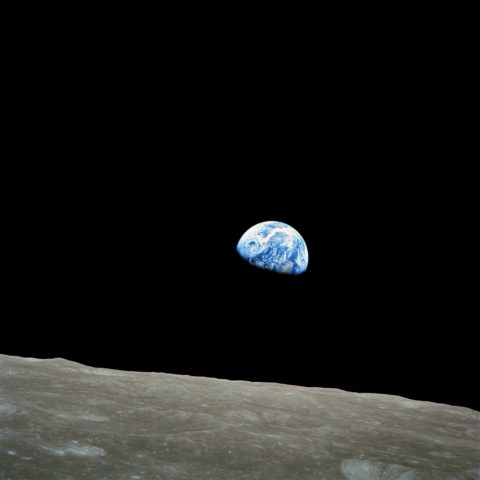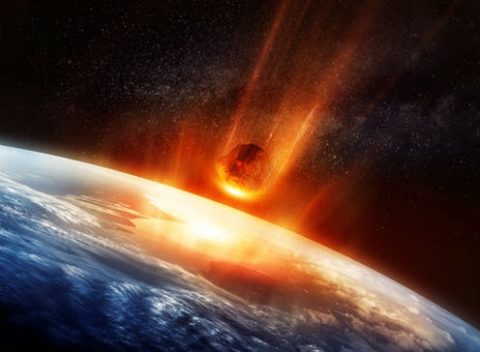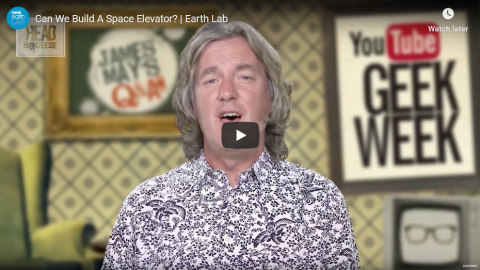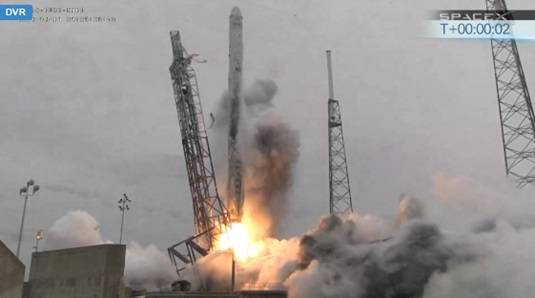Real Engineering
Published 11 Mar 2023
(more…)
June 18, 2023
Don’t Drop your Tools in Space
May 28, 2023
This Gun Could Reach Space
Real Engineering
Published 18 Feb 2023
(more…)
April 27, 2020
Entrepreneurs beyond the atmosphere
Doug Bandow reacts to Donald Trump’s executive order that begins to clear the way for private enterprise in space:

Taken by Apollo 8 crewmember Bill Anders on December 24, 1968, at mission time 075:49:07 (16:40 UTC), while in orbit around the Moon, showing the Earth rising above the lunar horizon.
Despite the current chaos caused by the coronavirus, Washington still must consider the future. Which explains the president’s new executive order that would allow private resource development on the moon and asteroids. It clearly rejects the “common heritage of mankind” rhetoric deployed by the United Nations on behalf of the Law of the Sea Treaty, which four decades ago created a special UN body to seize control of seabed resources.
The Future of Space Exploration
The EO issued earlier this month explained that
Successful long-term exploration and scientific discovery of the Moon, Mars, and other celestial bodies will require partnership with commercial entities to recover and use resources, including water and certain minerals, in outer space.
The measure began the process of revising an uncertain legal regime which currently discourages private sector development.
The administration pointed to the 1979 Agreement Governing the Activities of States on the Moon and Other Celestial Bodies (known as the Moon treaty) and the 1967 Treaty on Principles Governing the Activities of State in the Exploration and Use of Outer Space, including the Moon and Other Celestial Bodies (typically called the Outer Space Treaty). Neither is friendly to entrepreneurs or explorers with a commercial bent.
In response, the president announced that
Americans should have the right to engage in commercial exploration, recovery, and use of resources in outer space, consistent with applicable law. Outer space is a legally and physically unique domain of human activity, and the United States does not view it as a global commons. Accordingly, it shall be the policy of the United States to encourage international support for the public and private recovery and use of resources in outer space, consistent with applicable law.
Space is a Long-Term Prospect
The document’s main directive is for the Secretary of State, in cooperation with other agencies, to “take all appropriate actions to encourage international support for the public and private recovery and use of resources in outer space.” The secretary is to “negotiate joint statements and bilateral and multilateral arrangements with foreign states regarding safe and sustainable operations for the public and private recovery and use of space resources.”
Obviously, the administration’s attention is directed elsewhere at the moment. However, the potential benefits of turning to space are significant. The value of scientific research is obvious and continues to drive government agencies such as NASA. Launch services and space tourism have caught the interest of private operators. Such activities offer fewer legal and practical difficulties than attempting to establish some sort of long-term presence in the great beyond.
More complex development of space is a longer-term prospect. However, that makes it even more imperative to encourage innovation by creating institutions and incentives that encourage responsible development of what truly is the “final frontier.”
April 22, 2020
Can We Build A Space Elevator? | Earth Lab
BBC Earth Lab
Published 5 Aug 2013Getting to space in a rocket is expensive! One of the most popular alternative ideas is the space elevator, but is it really possible?
Here at BBC Earth Lab we answer all your curious questions about science in the world around you. If there’s a question you have that we haven’t yet answered or an experiment you’d like us to try let us know in the comments on any of our videos and it could be answered by one of our Earth Lab experts.
November 29, 2019
History of Space Travel – Red Star – Extra History – #4
Extra Credits
Published 28 Nov 2019Start your Warframe journey now and prepare to face your personal nemesis, the Kuva Lich — an enemy that only grows stronger with every defeat. Take down this deadly foe, then get ready to take flight in Empyrean! Coming soon! http://bit.ly/EHWarframe
While rockets had been proven to be indispensable to the Second World War, the idea to send people up into orbit was still seen as fantasy. Space was important only as a method to further the range of missiles meant to land oceans away from their original launch point. But a man named Korolev will change all of that, with work so secretive, he will be referred to as Chief Designer for nearly his entire life. But we all know the name of his first project into space: Sputnik.
From the comments:
Extra Credits
1 day ago
We weren’t able to fit her into the episode, but the other famous first cosmonaut in space is Laika, the Soviet space dog. She was a stray who was taken in by the program to test the Sputnik 2 and some of its life support features (like a coolant fan). Unfortunately, Laika did not return from her mission alive but she’s still regarded highly in the history of space flight and has become a symbol for the space race and animal testing in general. Look her up!
I remember reading in Robert Heinlein’s Expanded Universe of the day on his tour of the Soviet Union in 1960 when he and his wife were told by a group of Red Army cadets of a Soviet rocket launch carrying a human into orbit for the first time. The story was officially denied and the capsule was said to be unmanned after all. Wikipedia says:
According to Gagarin’s biography, these rumours were likely started as a result of two Vostok missions equipped with dummies (Ivan Ivanovich) and human voice tape recordings (to test if the radio worked) that were made just prior to Gagarin’s flight.
In a U.S. press conference on February 23, 1962, colonel Barney Oldfield revealed that an uncrewed space capsule had indeed been orbiting the Earth since 1960, as it had become jammed into its booster rocket. According to the NASA NSSDC Master Catalog, Korabl Sputnik 1, designated at the time 1KP or Vostok 1P, did launch on May 15, 1960 (one year before Gagarin). It was a prototype of the later Zenit and Vostok launch vehicles. The onboard TDU (Braking Engine Unit) had ordered the retrorockets to fire to recover, but due to a malfunction of the attitude control system, the spacecraft was oriented upside-down, and the firing put the craft into a higher orbit. The re-entry capsule lacked a heat shield as there were no plans to recover it. Engineers had planned to use the vessel’s telemetry data to determine if the guidance system had functioned correctly, so recovery was unnecessary.
November 11, 2019
Addressing the real extinction-level environmental threat
In the latest edition of the Libertarian Enterprise, L. Neil Smith points to what he thinks will be Donald Trump’s signature achievement: the United States Space Force.

The biggest nuclear weapon ever detonated on Earth, Tsar Bomba, was 50MT. The Chicxulub impact was, at these numbers, 2 million times as powerful as Tsar Bomba.
Image and caption from Stephanie Osborn’s “Incoming: The Chicxulub Impactor, Part 3 — The Impactor & Effects” at https://accordingtohoyt.com/2019/10/31/incoming-the-chicxulub-impactor-part-3-%e2%80%95-the-impactor-effects-by-stephanie-osborn/
Many thoughtful observers believe that the most significant thing that Donald Trump has accomplished so far is his appointment of dozens of federal judges who share his philosophy of governance and I, amateur historian that I am, am inclined to agree with them — with one exception, that is, a little item that just might prove to be a thousand times, a million times, a billion times more important than anything else the Donald — or anybody else, for that matter — has ever done.
Most of us have become aware of the way that a relatively small piece of rock — an asteroid approximately the size of Manhattan Island or the Matterhorn — changed the course of life-history on this planet. It struck the Earth at 40,000 miles and hour, hitting what is now the northern coast of the Yucatan, generating a titanic explosion that ignited every plant standing above the ground, raising a tidal wave that swept over most of North America, and opening a chain of deadly volcanoes on the other side of the world, near India. The esteemed Bob Bakker to the contrary, the late, lamented dinosaurs, I believe, died from smoke inhalation.
Three quarters of all life on this planet, plant and animal, land and sea, was brutally exterminated by this “Cretaceous-Tertiary Event”, and apparently not for the first time. There was a much worse die-off between the Permian and the Triassic eras. The important fact, for you and me, is that there are thousands, if not millions of other lethal asteroids still out there, with which our vulnerable little blue marble is still playing a murderous game of roulette. It is only a matter of time before another “extinction-level event” occurs, possibly wiping out every last living entity on Earth. We can see plenty of evidence of that kind of phenomenon, that magnitude of destruction, elsewhere in the Solar System.
Take your precious carbon footprints and stuff them where the sun don’t shine, Greta. It is Donald Trump who has made the historic first move to prevent this very real cataclysm, and probably to extend the life of the human species indefinitely (an idea environmentalists hate), by calling for the organization of a United States Space Force. At this moment it still isn’t clear exactly what methods will work best to destroy or divert asteroids that threaten our home-world (I mention possibilities in my 2010 Ngu Family Saga novel Ceres), but it is something that must be done, sooner or later, probably by manned spacecraft.
The other important task for which we need a Space Force is to clean up the tens of millions of items of orbital debris that NASA and other agencies have very sloppily left circling over our heads. Remember when the Gemini astronauts simply threw those expensive Hasselblad cameras out the door? These objects range in size from particles of dust to cast-off booster stages which endanger satellites and spacecraft. A hunk of junk the size and shape of a small screw can damage solar panels, pressurized living and working spaces, as well as helmeted individuals in spacesuits, to whom that flying screw would be like a bullet through the head.
January 3, 2018
BAHFest London 2017 – Louie Terrill: Why the Kessler Syndrome is key to humanity’s future
BAHFest
Published on Dec 11, 2017Watch Louie Terrill at BAHFest London 2017 present his theory, “Making sure we’re all in this together: Why the Kessler Syndrome is key to humanity’s future.”
BAHFest is the Festival of Bad Ad Hoc Hypotheses, a celebration of well-researched, logically explained, and clearly wrong scientific theory. Additional information is available at http://bahfest.com/
December 23, 2015
SpaceX Falcon 9 performs successful launch and controlled landing
William Harwood reports for CBS News:
Making its first flight since a catastrophic launch failure last June, an upgraded, more powerful SpaceX Falcon 9 rocket roared to life and shot into space Monday, boosting 11 small Orbcomm data relay satellites into orbit in a major milestone for the California rocket builder.
In a significant space “first,” the Falcon 9’s first stage fell back into the atmosphere and pulled off a powered landing at the Cape Canaveral Air Force Station, settling to a smooth tail-first touchdown in a convincing demonstration of reusability, a key requirement for lowering commercial launch costs.
In a scene resembling a launch video running in reverse, the booster quickly dropped out of a cloudy sky atop a jet of flame from one of its Merlin 1D engines, heralded by twin sonic booms that rumbled across Florida’s Space Coast. Cheers erupted in company headquarters in Hawthorne, California, as the stage settled to a smooth touchdown.
In another first, the Falcon 9 used colder, denser-than-usual liquid oxygen and kerosene propellants, a significant upgrade allowing the booster’s nine first-stage engines to generate more power, increasing their combined liftoff thrust from 1.3 million pounds to 1.5 million, or 170,000 pounds of thrust per engine.
The launch, first-stage landing and satellite deployments all appeared to proceed without a hitch, a welcome success for a company returning to flight after a disheartening failure.
“Everything we’ve seen thus far in the mission appears to be perfect,” SpaceX founder Elon Musk said in a conference call with journalists. “The satellites were deployed right on target and the Falcon 9 booster came back and landed. Looks like almost dead center on the landing pad. … As far as we can see right now, it was absolutely perfect. We could not have asked for a better mission.”
There and back again pic.twitter.com/Ll7wg2hL1G
— Elon Musk (@elonmusk) December 22, 2015
October 18, 2014
Unmanned X-37B returns to earth after nearly two years in orbit
In the Telegraph, Rob Crilly tells us what is known about the X-37B’s mission:
It arrived back at a California air base after dark. Only the eagle-eyed would have spotted the snub-nosed spacecraft gliding out of the black sky.
Officially, the unmanned Boeing-built X-37B Orbital Test Vehicle had just completed its longest ever mission, spending almost two years circling the Earth, conducting experiments.
But its secretive history has sparked countless theories about what the computer controlled craft was really doing in space.
One idea is that the US Air Force has developed a drone spy ship, which it uses to shadow Chinese satellites. Another more fanciful claim is that it has been developed to engage in sat-napping — gobbling up rival spy satellites like something from a James Bond film.
There were few clues in an official press release.
“The landing of OTV-3 marks a hallmark event for the program,” said an unidentified programme manager quoted in the Air Force statement.
“The mission is our longest to date and we’re pleased with the incremental progress we’ve seen in our testing of the reusable space plane. The dedication and hard work by the entire team has made us extremely proud.”
May 25, 2014
Russian rocket export ban means increasing opportunities for private enterprise in space
Strategy Page looks at the knock-on effects of the Russian government banning the export of rocket engines to the United States:
The U.S. government is being forced to use satellite launchers developed without government financing because the usual methods of obtaining these launchers is falling apart and currently is unable to supply enough rockets to get all American military satellites into orbit. The immediate cause of this problem is the recent (since earlier this year) Russian aggression against Ukraine. The U.S. responded to this aggression by placing sanctions on some Russian officials and firms. Russia responded to that by halting RD-180 shipments to the United States. That’s breach of contract and it will do enormous damage to Russian exports in the future because now many countries and firms realize that a contract with a Russian firm can be cancelled by the Russian government for any reason. This was always seen as a risk when doing business with Russia and many Western firms declined to do so or have pulled out of Russia in the last decade because of the growing unreliability of Russia as a business partner. The RD-180 affair got a lot of publicity, all of it bad with regard to future Russian exports of high-end industrial items. Europe, which gets about a third of its natural gas from Russia, is already looking for alternate sources and investors are fleeing Russia (and taking their money with them).
[…]
This is good news for the new private firms that are developing rockets for launching stuff into orbit. One such firm is SpaceX (Space Exploration Technologies Corporation) and is has been trying to break the current cartel controlling U.S. government satellite launch services. Since 2006 all this business has gone to a government-approved monopoly called the ULA (United Launch Alliance) which is composed of Lockheed Martin (Atlas 5 rocket) and Boeing (Delta 4). These two firms have dominated U.S. space launches for over half a century. Because of the RD-180 the Atlas 5 is more attractive (in terms of performance and price) than the Delta 4. Meanwhile SpaceX expects to have Atlas 5 competitor ready in a few years.
In 2012 SpaceX obtained its first contract to launch U.S. military cargo into space. SpaceX had earlier obtained a NASA contract which included 12 deliveries to the International Space Station (at $134 million each). What makes all this so noteworthy is that SpaceX developed its own launch rockets without any government help. SpaceX also developed the Dragon space vehicle, for delivering personnel and supplies to the International Space Station.
SpaceX has since proved that its rockets work and is pointing out that the SpaceX rockets can do the job cheaper that ULA. Currently ULA gets a billion dollar a year subsidy from the government that SpaceX would not require. SpaceX still has to get all the paperwork and approvals done so that they can handle classified missions. SpaceX does not see this as a problem, it’s simply going to take another year to satisfy all the bureaucrats and regulations.
May 1, 2014
SpaceX and the successful re-entry experiment
Amanda Wills talks about the most recent SpaceX achievement:
When SpaceX launched its Dragon supply mission to the International Space Station on April 18, it tried something revolutionary after the spacecraft was safely in orbit.
Behind the scenes, CEO Elon Musk and his team had been testing the reusability of this rocket. On that Friday, the team returned part of it to Earth for the first time in history. Once Dragon was in space, the first stage separated and re-entered Earth’s atmosphere. As the helium-filled rocket slowed, it extended four 25-foot-long landing legs and used its thrusters to briefly hover over the Atlantic Ocean before plopping down ever so gently onto its surface.
Musk and his team pulled it off — a huge feat considering that the chance of success was only around 30% to 40%. The SpaceX team recovered the raw video from the camera that was on board Falcon 9, and software engineers have spent the last week trying to repair the footage, which was taken just before splashdown.
[…]
The team was able to bring back the first stage. The rocket was clearly vertical — an important detail in testing reusable rockets — and the soft landing was successful. However, the weather wasn’t cooperative that day and the stage was destroyed by rough waves. Fortunately, Musk said his team was able to recover bits of the rocket.
April 19, 2014
ISS resupply mission successfully launched
And another story from yesterday that I would have covered:
The Falcon 9 rocket lifted off from Cape Canaveral on schedule at 12:35pm PDT (8:35pm UTC), carrying 5,000 pounds of supplies for the ISS. The first stage separated cleanly two minutes and fifty one seconds into the flight, 103km above the launch pad, and the Dragon capsule has deployed its solar panels and is now on course to dock with the ISS in two days, once orbital paths have matched up.SpaceX shoots off the launch pad right on time
It was a very close run thing. The CRS-3 mission was due to take off on Tuesday but was cancelled after a helium leak was detected. Friday’s launch was much tighter, and SpaceX said the launch had a one-second window if the rocket was to successfully insert its cargo into the right orbital plane.
Weather was a big worry for the SpaceX team. There was rain and relatively heavy clouds at the launch site, and the team floated multiple weather balloons into the upper atmosphere to make sure that winds weren’t too strong at altitude.
Unfortunately, the heavy winds and storm conditions in the Atlantic may hamper the second part of Friday’s mission: the remote landing of the first stage of the Falcon 9 rocket. After separating, the booster is planned to fire up again and slow down, falling back towards the Earth.
If all goes well, the rocket will then deploy four legs, which were covered for the initial launch phase, and begin a controlled burn to slowly sink towards the ocean and hover for landing and retrieval. At least, that was the plan.
But the inclement weather means the SpaceX support ship that was due to witness the rocket’s return and retrieve the hardware couldn’t get into position. SpaceX says it will attempt the soft landing anyway, but there’s no word yet on its success or otherwise.
November 19, 2012
Space-Age technology on Earth, but not so much in space
In The Register, Shaun Dormon explains why almost all the electronic components used on modern spacecraft, satellites, and the International Space Station (ISS) are actually not cutting-edge, top-of-the-line items:
I hate to say it, but most of what you think about space-age technology is a total fabrication. It’s the stuff of sci-fi.
Perhaps the biggest misconception of all is that spacecraft are equipped with cutting-edge computing platforms that any self-respecting technophile would commit unspeakable acts to get their mitts on.
If only. The fact of the matter is that even the most advanced chips up there were considered obsolete ten years ago down here. Although it’s true that in space no one can hear you scream, outer space is actually a very noisy place, electromagnetically speaking.
The computer on your desk is very unlikely to experience much in the way of EM radiation unless someone cuts a hole in the side of the kitchen microwave. Out in orbit, though, there are many sources of radiation, ranging from the relatively mundane stuff pouring out of the Sun and collecting in the Van-Allen radiation belts to more exotic things such as cosmic rays and other high-energy particles that cause so-called “single-event effects”.
[. . .]
The damage is cumulative. Individually, an impact causes the ionisation of a single oxide molecule present in the semiconductor. It’s not enough to cause instant failure, but as more and more impacts take place, the effects combine to significantly alter the electrical properties of the circuit until it can no longer function correctly.
More exciting dangers arise from exposure to gamma or cosmic rays. These ultra-high energy impacts cause localised ionisation which results in an unexpected flow of current. In the case of a lower energy event, this may result in a “single event upset” or “bit-flip”, and data corruption can ensue. These are not usually fatal to the system. No so the worst case “single event burnout”, which creates such high currents that the very circuitry itself is burned out almost instantaneously.
October 29, 2012
The Dragon returns, bearing cargo
At The Register, Brid-Aine Parnell reports on the mostly successful cargo delivery round-trip by SpaceX’s Dragon capsule:
The reusable cargoship dropped into the ocean yesterday evening around 250 miles off the coast of Mexico after resupplying the ISS and its crew. The Dragon was ferried to a port near Los Angeles where it will be prepped for its return to SpaceX’s test facility in Texas.
Some of the cargo brought back by the capsule is due to be returned to NASA in the next couple of days, including research samples from the station’s microgravity environment. The ship delivered 882 pounds of gear to the ISS, including scientific research and crew supplies. It returned with nearly twice that weight of stuff.
The mission was only a part-success, as the secondary objective was to launch a satellite for Orbcomm, but due to a malfunctioning engine in the launch phase, the satellite could not be placed in the correct orbit and was lost. Orbcomm is sticking with SpaceX for two more satellite launches in spite of this initial failure.
October 17, 2012
Elon Musk drops hints about next SpaceX development direction
Zach Rosenberg reports on the next big thing we can expect from SpaceX:
Launcher developer SpaceX has promised a new engine for a new rocket, larger than the Falcon 9 that NASA expects to become a mainstay of its Earth orbit operations.
Elon Musk, the Silicon Valley entrepreneur who successfully parlayed the fortune he earned founding PayPal into launch systems developer SpaceX, said the new engine would not be based on the 160,000lb-thrust (712kN) Merlin 1 series that powers Falcon 9.
Musk said the new rocket, which he calls MCT, will be “several times” as powerful as the 1 Merlin series, and won’t use Merlin’s RP-1 fuel. Beyond adding that it will have “a very big core size”, he declined to elaborate, promising more details in “between one and three years”.
Musk declined to say what ‘MCT’ stands for, and declined to answer further questions on the project.






